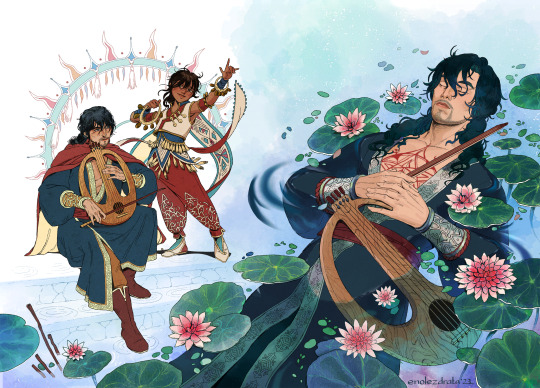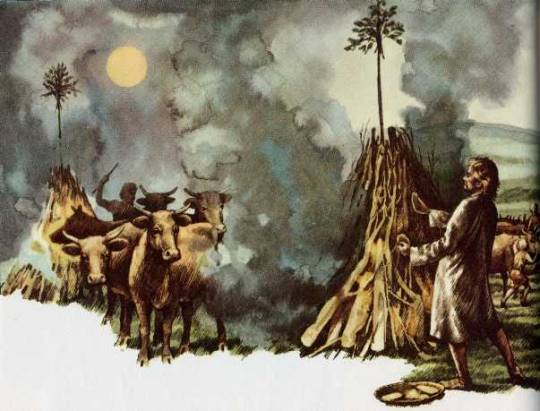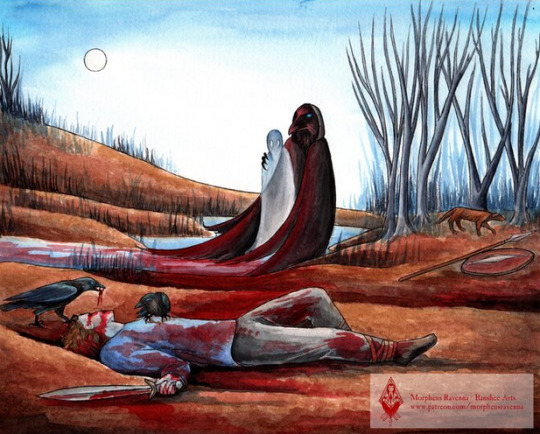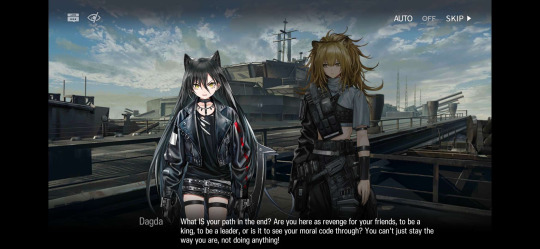#an dagda
Text

#dagda#an dagda#illustration#art#digital art#Irish mythology#Irish paganism#doodles#Celtic mythology
177 notes
·
View notes
Text
It'd be cool to come up with Pagan alternatives to the days of the week in the Gaelic languages, since the current ones have such Christian meanings
DiLuain can stay since moon worship is a thing, but perhaps we might change the Latin to "Latha na Gealaich"?
DiMairt could be "Latha na Mhór-ribhinne" (The Morrigan's Day) in keeping with the "M" sound of "Mairt"
DiCiadain needs to go since it refers to a Christian fast, so why not make it Latha an Daghdha? (A sort of oblique reference to Wednesday being "Wodan's Day" in English perhaps?
DiarDaoin again refers to fasts, so maybe "Latha Lùgha"?
DihAoine, another fast, so how about "Latha Aoidh" since it sounds kinda similar to "aoin"?
DiSathairne isn't Christian so much as the wrong kind of pagan, so I'm not against leaving it as is, but as long as we're going with new names, why not "Latha Manannain"?
DiDòmhnaich is perhaps the most explicitly Christian, but since we have "Latha na Gealaich" already, I propose substituting "Latha na Gréine"
I was obviously a bit inspired by the Germanic names here, but I'm curious to see what everyone else's thoughts are! I came up with these off the top of my head, so I make no guarantees about their appropriateness or linguistic accuracy (I'm a Gaelic learner, not a fluent speaker).
#gaelpol#gaelic polytheism#gaelic paganism#scottish gaelic#gàidhlig#gaidhlig#paganism#pagan#an dagda#the morrigan#lugh#aed#manannan mac lir#ireland#irish mythology#gaelic mythology
49 notes
·
View notes
Text
Behold the fairy mound before your eyes;
It is plain for you to see, it is a king’s dwelling,
It was built by the harsh Dagda:
It was a shelter, it was a keep renowned for strength.
Although the name is translated as ‘the harsh Dagda’ here (which is a perfectly valid interpretation), the range of other meanings that are suggested by dúr could be interpreted as equating dúr (or duir, as it’s sometimes spelled) with dair (also sometimes spelled duir), because dúr can be given to mean ‘hard, rigid, solid,’ but also ‘firm, resolute, hardy,’ which offers a perfect complement to the hardy qualities of the oak. In the context of the Dagda having built the brug itself (using construction materials like oak), where the strength of its fortifications are emphasised, a translation of ‘the steadfast Dagda’ would perhaps be more apt, or perhaps even ‘the oaken Dagda.’
– "A Guide to Ogam Divination" by Marissa Hegarty.
#ogham#ogam#damn the links between Dair and Tinne are makingnmy brain fire on ALL cylinders#lowkey this is helping slot into place a TON of UPG#im so thrilled to have found this book#i didnt know it wss being written#marissa hegarty#Dair#an Dagda
24 notes
·
View notes
Text


#witchcraft#witchblr#witch community#witchcore#witch business#pagan#pagan blog#paganism#celtic pantheon#celtic paganism#dagda#an Dagda#the dagda
9 notes
·
View notes
Text
An Dagda at Brú na Bóinne
Praise be An Dagda
The good god
The king of Sí an Brhu
Bringer of Boyne's plenty
Soil rich with the powers of life
His kingdom the bower of death
Flanked with stony guardians
Lit deep below by December's sun
The darkness receding at that place
The spirals of earth sky sea in stone
That flicker from 5,000 years before
As he watches us ascend to light
---
I got the opportunity to visit Newgrange recently, and I wrote this poem shortly after. What an incredible, moving place. I have never felt so close to a god, but I was welcomed there with the absolute certainty that I was meant to see this place. I am beyond thankful I was able to go.
5 notes
·
View notes
Text
Crow Folks: We’ve Reached the Herald of Wands
A few months back, as part of my monthly ritual to Na Morrigna to seek a message for the coming moon cycle, I was guided to use tarot to connect, and since then we’ve been following the Suit of Wands, from the Seven to the Herald, the card that showed up in the original reading reversed. At this latest Dark Moon, we’ve now arrived at the Herald of Wands, finally upright, and thus bringing us some much-needed relief! Upright, the Herald speaks of good news, optimism, and satisfaction. It’s time for the last harvest, and we’ve done well for ourselves. I could personally use a little rest and relaxation! And it’s always nice to hear that our efforts have been successful. Being as this month is election month here in the US, and Election Day falls on the next full moon, I’m tentatively optimistic about that, as well. (But you can bet I did another round of politically-focused magic this dark moon!) Time will tell. (But please - vote!)
This month when I went to journey to Na Morrigna, I found myself led not to the place I usually go to see the three sisters, but to Ráth Cruachan, a place I have only seen photographs of, and ruins at that. But it was unmistakably clear to me, in the way things sometimes are in journeys. The fort itself was standing, not a ruin, but I did not go inside the walls. Instead, I was drawn to a small cauldron hanging over a firepit in front of the walls, somewhat to the left of the gate. There, I found just one sister, whom I addressed as Morrigu, and with her was An Dagda, which was also somewhat unexpected. No poetry they asked of me this month, and no great news, just a request for my household Samhain celebration: when we feast, let it be meat that we cook outside over flame, and let one piece fall onto the coals and stay there, as an offering to Them.
So instead, I leave you with this piece of Old Irish poetry, translated by Morgan Daimler (and found in their book “Tales of the Tuatha De Dannan”). The full poem is about foods fit for each festival, and here is the stanza for Samhain:
Meat, beer, nuts, tripe,
They are suitable food for Samhain,
Bonfire on a hill with a company,
Buttermilk, a roll of new butter.
3 notes
·
View notes
Text
when i shout "Good God!" and people think i'm appalled, but really i'm just talkin about An Dagda
1 note
·
View note
Text


My contribution to the local WHA zine

708 notes
·
View notes
Text

Custas and Dagda busy protecting their wares 💤
#phone art#witch hat atelier#2023#dagda#coustas#custas#my mans gonna wake up with a spine like an accordion
450 notes
·
View notes
Text
Important Facts about Samhain from an Irish Celtic Reconstructionist



Pronunciation
SOW-in or SOW-een ~NOT~ Sam-han, Sam-win etc.
Dates
Most reconstructionists celebrate Samhain on Oct 31-Nov 1, however some may choose to celebrate on Gregorian Nov 13-14 as this would match the Julian dates of Oct 31-Nov 1. Some also believe that it was a three day festival spanning Oct 31- Nov 2 on which Nov 2 is specifically devoted to ancestral veneration, but there is no specific evidence of this, only possible extrapolation from more modern practices.
Following the Celtic method of days beginning at sunset, regardless of the specific dates you choose to celebrate on your festivities should begin at sunset and end at sunset.
Importance in the Mythos
Ná Morrighan has a strong connection to this time of year thanks to the story of Cath Dédenach Maige Tuired (The Last Battle of Mag Tuired) in which she is found depicted as the ‘Washing Woman’ (sometimes washing herself in the river and other times washing the bloodied armor of the soldiers that would die that day), on the eve of the battle which is also Samhain. The Dagda approaches her and couples with her (creating the ‘Bed of the Couples’ along the bank of river and granting Dagda her blessing in the battle to come). This encounter seems to over emphasize the liminality of the encounter by taking place during the changing of the year and with the couple each standing with ‘one foot on either bank’ of the river.
She and her sisters (Badb and Macha) then use various forms of magic to rain destruction on their enemies (in the form of fire and blood). After the day is won Morrighan speaks a prophecy that describes what is taken by some to be the end of days and others to be the events which will later lead to the Ulster Cycle.
Beneath the peaceful heavens lies the land.
It rests beneath the bowl of the bright sky.
The land lies, itself a dish, a cup of honeyed strength, there, for the taking, offering strength to each
There it lies, the splendour of the land.
The land is like a mead worth the brewing, worth the drinking.
It stores for us the gifts of summer even in winter.
It protects and armours us, a spear upon a shield
Here we can make for ourselves strong places, the fist holding the shield
Here we can build safe places, our spear-bristling enclosures.
This is where we will turn the earth. This is where we will stay.
And here will our children live to the third of three generations
Here there will be a forest point of field fences
The horn counting of many cows
And the encircling of many fields
There will be sheltering trees
So fodderful of beech mast that the trees themselves will be weary with the weight.
In this land will come abundance bringing:
Wealth for our children
Every boy a warrior,
Every watch dog, warrior-fierce
The wood of every tree, spear-worthy
The fire from every stone a molten spear-stream
Every stone a firm foundation
Every field full of cows
Every cow calf-fertile
Our land shall be rich with banks in birdsong
Grey deer before Spring
And fruitful Autumns
The plain shall be thronged from the hills to the shore.
Full and fertile.
And as time runs its sharp and shadowy journey, this shall be true.
This shall be the story of the land and its people
We shall have peace beneath the heavens.
Forever
(based on the translation by Isolde Carmody)
It is also mentioned in Echtra Cormaic that on this festival every seven years the high king would host a feast, it was at this time new laws could be enacted. (but it seems that individual Tuathas or possibly kings of the individual providence may have done this for their territories at Lughnasadh).
It seems to be a time considered especially susceptible to (or of) great change as it is the time which the Tuatha de Danann win victory over the Formorians and take control of Ireland, the invasion of Ulster takes place at this time in Táin bo Cúailnge, in Aislinge Óengusa Óengus and his bride-to-be are changed from bird to human and eventually he claims kingship of Brú na Bóinne at this time of year.
Celebration Traditions
Samhain is the beginning of the “dark half” of the year and is widely regarded as the Insular Celtic equivalent of the New Year. The “dark half” of the year was a time for story telling, in fact in this half of the year after dark is considered the only acceptable time to tell stories from the mythological and Ulster cycle (the Fenian cycle being assumed to be no older than the 12th century based on linguistic dating). Traditionally anything that had not been harvested or gathered by the time of this festival was to be left, as it now belonged to the Fae (in some areas specifically the Púca).
This was also an important time for warding off ill luck in the coming year. Large bonfires would be built and as the cattle were driven back into the community from the pastures they would be walked between these bonfires as a method of purification (the reverse custom of Bealtaine where the livestock were walked between the fires on their way out to the summer pastures). Assumed ritualistic slaughter of some of the herd would follow (though this perhaps had the more practical purpose of thinning the herd before the winter and creating enough food for the feasting). In some areas the ashes from these fires would be worn, thrown or spread as a further way to ward off evil.
Homes would be ritualistically protected from the Aos Sí (Fae or ‘Spirits’) through methods such as offerings of food (generally leaving some of the feasting outside for them), carving turnips with scary faces to warn them off (we now tend to do this with gourds), and smoke cleansing the home (in Scottish saining) traditionally with juniper, but perhaps rowan or birch might be an acceptable alternative. It is likely these would be part of the components used in Samhain bonfires as well, for the same reason.
Lastly based on later traditions as well as links in the mythology this is a time where divination practices or those with the ‘second sight’ were regarded to be especially potent.
Art Credit @morpheus-ravenna
#samhain#irish#irish mythology#irish polytheism#irish paganism#celtic reconstructionism#celtic paganism#celtic polytheism#na morrigna#the morrígan#the dagda#fire festival#blackcrowing#Irish reconstructionist
449 notes
·
View notes
Text

Grianstad shona daoibh!
In Ireland, the Winter Solstice is often associated with the Newgrange passage tomb in County Meath. Each year, as the sun rises on the Solstice, it aligns perfectly with tomb to illuminate the passage within.
Lots of historical, scientific and even crazy (I’m looking at you Ancient Aliens) theories exist as to why this occurs, but there is also some stories within our mythology associated with the event, including the Dagda’s affair with the Goddess Boann.
The Dagda was thought to be an Irish god of fertility and strength. A wife of one of his aides, Boann, a goddess of the River Boyne, was particularly entranced, and the couple soon began a clandestine affair. Affairs don’t stay secret when a god of fertility is involved, and Boann quickly fell pregnant around springtime.
Boann resided at Newgrange, and when her husband left for a hunting trip, the Dagda cast a spell to make the sun standstill for nine months and pause time. Boann carried her baby to term and eventually gave birth to Aengus, a god of youth and love. Despite it now being Winter, on Elcmar’s return he felt as if only a day had passed and the affair went unnoticed. That is until one day, when an adult Aengus would eventually arrive to duel Elcmar for Newgrange, which he deemed his birthright.
#irish mythology#artists on tumblr#irish folklore#newgrange#winter solstice#aengus#the Dagda#Boann#celtic polytheism#amylouioc art#my art#celtic mythology#fantasy illustration
237 notes
·
View notes
Text
90% of the time I'm like "the only reason why the medieval Irish material seems bizarre is because it isn't taught as part of the standard humanities curriculum -- Greek Mythology is just as bizarre, you're just USED to it, stop reducing this stuff to Lol That's So Weird", but then I do have to be like. "Anyway the postulated father god of the postulated pre-Christian Irish pantheon, if ever such a thing existed in a uniform way, creates a zombie apocalypse in one text that allows him to become king of Ireland and his wife is a crow (part time) that commits crimes and castrates a Viking warlord (who has a really messy family life btw). He also has a xylophone made out of corpses in another text." and I have to be like. "Okay, so maybe the Irish texts ARE a little bit. Out there. On occasion."
#for what it's worth though there's still a REASON for these things#the scribes weren't putting them in because Lol Funny#but also...yeah.#Zeus could never#irish mythology#the mythological cycle#the dagda#i should clarify: they weren't JUST putting them in because Lol Funny
172 notes
·
View notes
Note
Dreamer, why'd they go and bury all the character building Glasgow should have had in the last chapter over in Dagda's Operator Record.



What the fuck.
Yeah, great question, why ISN'T this in the main story instead of a locked cutscene not many people are going to see?
114 notes
·
View notes
Text

*・゜゚Witch Hat Atelier Men🤎🩶
#witch hat atelier#tongari boushi no atelier#wha fanart#dagda wha#qifrey#artists on tumblr#olruggio#galga#illustration#my art <3
127 notes
·
View notes
Text

Dagda icon comm
126 notes
·
View notes
